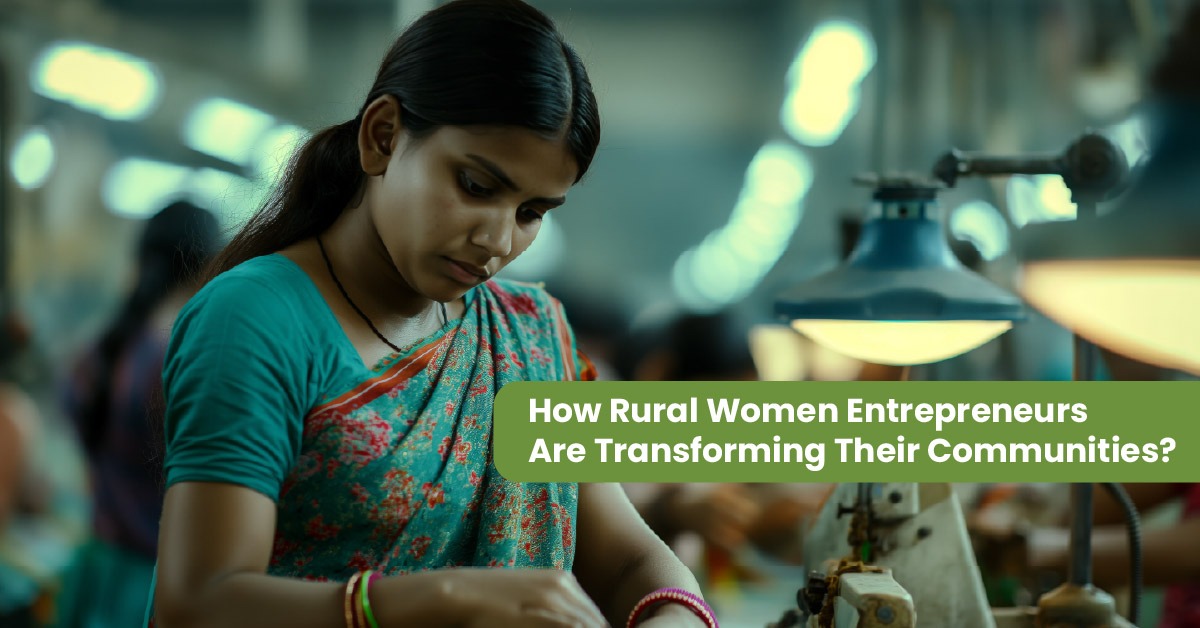In India, over 20% of MSMEs are owned by women, with around 8.05 million women-led MSMEs, many of them in rural areas. These businesses are crucial to local economies, creating jobs, especially for other women, and offering products and services that meet the unique needs of rural communities. However, the growth of women-owned MSMEs has been uneven, primarily due to challenges like limited access to finance and proper support infrastructure. As more rural women venture into entrepreneurship, it’s becoming clear that supporting them can open new opportunities and lead to real, positive change in society.
The Rise of Rural Women Entrepreneurs
The Shift from Household Work to Business Ownership
Traditionally, rural women were confined to household responsibilities and unpaid labour in agriculture. However, with increased access to education, financial support, and digital platforms, women are now stepping into entrepreneurship.
According to the Economic Survey of India 2023-24, the labor force participation rate (LFPR) for rural women has nearly doubled, rising from 24.6% in 2017-18 to 47.6% in 2023-24. This reflects a growing ambition among women to achieve financial independence.
Sectors Where Rural Women Are Leading
Rural women entrepreneurs are thriving in various sectors, including:
- Handicrafts and Textiles: Traditional weaving, embroidery, and block printing businesses.
- Agriculture and Allied Activities: Organic farming, dairy farming, and food processing units.
- Retail and Small Enterprises: Kirana stores, tailoring shops, and beauty salons.
- E-commerce and Digital Businesses: Many rural women are now selling their products via online platforms.
This shift is not just about personal growth, it’s about revitalizing rural economies and creating sustainable development.
The Impact of Rural Women Entrepreneurs on Their Communities
1. Employment Generation
Women-led rural enterprises have become a major source of employment. According to the MSME Ministry, women-owned businesses provide jobs to nearly 22-27 million people in India. This has led to:
- Better wages and fairer working conditions for rural workers.
- Economic stability for families and reduced migration to urban areas.
2. Financial Inclusion and Independence
Women entrepreneurs are breaking financial barriers by:
- Accessing microloans and government schemes like the Mudra Yojana, which has disbursed over ₹27 lakh crore in loans to small businesses, many of which are women-led.
- Managing personal and household expenses independently, reducing economic dependence on male family members.
3. Social Transformation and Gender Equality
- Women entrepreneurs challenge societal norms by proving that business ownership is not just for men.
- They become role models for the younger generation, inspiring more girls to pursue education and careers.
4. Digital and Technological Advancement
With the rise of digital banking, mobile wallets, and e-commerce, rural women now have greater access to:
- Online marketplaces like Amazon Karigar, Flipkart Samarth, and Meesho where they can sell their handmade products.
- Skill development programs in digital literacy and financial management.
A report by NASSCOM (2023) found that over 3 million rural women entrepreneurs are using digital platforms to expand their businesses.
Related Blog: The Role of Women in Rural Development: Driving Economic and Social Change
Challenges Faced by Rural Women Entrepreneurs
Despite their success, rural women entrepreneurs still face significant challenges:
1. Limited Access to Credit and Financial Services
- Many banks and financial institutions consider women high-risk borrowers due to a lack of collateral (such as land or property).
- Only 14% of women in rural India own land, which restricts their ability to secure loans.
2. Balancing Family Responsibilities with Business Growth
- Women continue to bear most household and childcare duties, leaving less time for business expansion.
- Lack of family support can discourage women from pursuing entrepreneurial ventures.
3. Market and Infrastructure Barriers
- Poor road connectivity and unreliable electricity make it difficult for rural women to run businesses efficiently.
- Many women struggle with limited access to larger markets, restricting their ability to scale operations.
4. Social and Cultural Constraints
- Gender biases still exist, with some communities discouraging women from working outside the home.
- Lack of education and digital literacy in some areas limits women’s ability to use technology effectively.
Government Schemes and Support for Women Entrepreneurs
To address these challenges, various government and private initiatives have been introduced:
1. Government Schemes
- Pradhan Mantri Mudra Yojana (PMMY) – Provides collateral-free loans up to ₹10 lakh for small businesses.
- Stand-Up India Scheme – Ensures at least one-woman entrepreneur per bank branch receives financial assistance.
- Rural Skill Development Schemes – Programs like Deendayal Antyodaya Yojana and National Rural Livelihoods Mission (NRLM) provide vocational training.
2. Private Sector and NGO Support
- Self-Help Groups (SHGs) – Community-based financial support networks that help women save, borrow, and invest.
- Women’s Entrepreneurship Platforms – Organizations like WE Hub, SEWA, and NITI Aayog’s WEP help women scale their businesses.
With continued financial and policy support, the future looks promising for rural women entrepreneurs in India.
The Future of Rural Women Entrepreneurship
The next decade holds immense potential for women-led businesses in rural India. Key trends shaping the future include:
1. Expansion of Digital and E-commerce Platforms
- More rural women will sell their products online, increasing their income and market reach.
- Social commerce platforms like Instagram and WhatsApp Business will enable women to market their goods directly to consumers.
2. Sustainable and Green Businesses
- Women entrepreneurs are leading eco-friendly businesses, from organic farming to sustainable textile production.
- Government initiatives promoting green businesses will further empower women in these sectors.
3. Increased Investment in Women-Owned Businesses
- More corporate social responsibility (CSR) funds and venture capitalists are investing in women-led startups.
- Organizations are promoting financial literacy programs to help women make informed investment decisions.
How We Can Support Rural Women Entrepreneurs
1. Buy Local, Buy Handmade
Supporting locally made products from rural women can directly boost their businesses.
2. Promote Digital and Financial Literacy
Encouraging women to learn digital skills can help them scale their businesses.
3. Advocate for Policy Changes
Pushing for better financial policies, infrastructure, and gender equality will ensure long-term growth.
Related Blog: Why Is the Participation of Women in Rural Development Essential?
Conclusion: A New Era of Women-Led Growth
The rise of rural women entrepreneurs is not only about financial independence but also about empowerment, breaking barriers, and reshaping traditional roles. As they navigate challenges, these women are creating a way for others to follow, creating jobs, and strengthening their communities. Their journey is one of resilience and hope, showing how a small idea can spark big changes for generations to come.


